Integrated Pest Management: A Sophisticated Approach to Chemical Use
VerifiedAdded on 2023/06/11
|10
|1547
|497
Report
AI Summary
This report explores the application of Integrated Pest Management (IPM) as a sophisticated approach to reducing chemical use in cotton crops in Australia. It identifies major and minor pests affecting cotton plants and discusses the harmful effects of synthetic insecticides, including health implications, environmental contamination, and soil degradation. The report advocates for IPM, which combines resistant varieties, biological controls, and cultural practices to manage insecticide resistance and environmental contamination. Key IPM practices include understanding pests, adopting a year-round approach, considering farm surroundings, exploring pest avoidance, effective crop sampling, promoting healthy crops, and applying resistance management principles. The report also addresses the development and implementation of IPM strategies, highlighting benefits like improved yields and reduced human impact, while acknowledging challenges such as lack of education and poor regulation. The report concludes by referencing various studies that support the benefits of IPM in reducing chemical use and promoting sustainable agriculture.
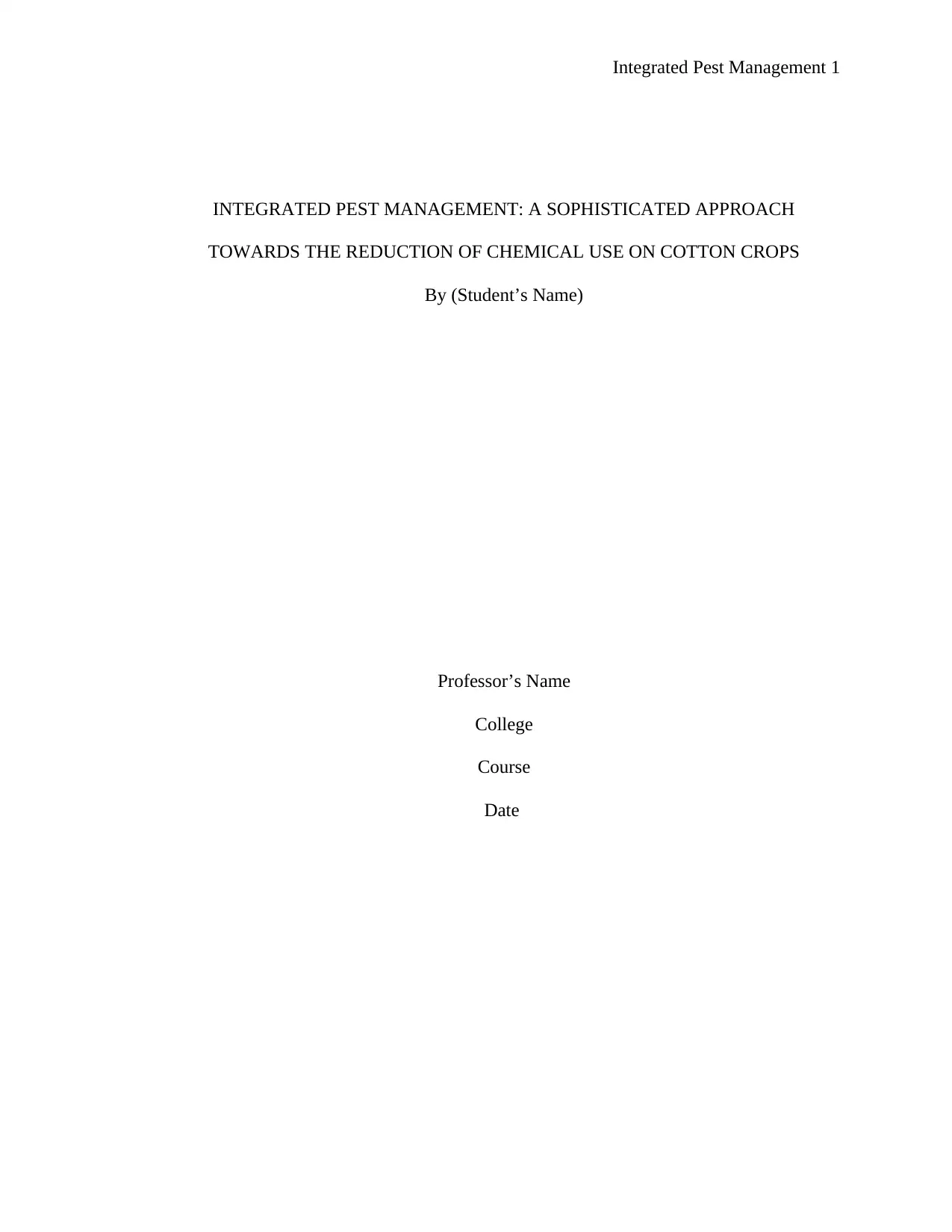
Integrated Pest Management 1
INTEGRATED PEST MANAGEMENT: A SOPHISTICATED APPROACH
TOWARDS THE REDUCTION OF CHEMICAL USE ON COTTON CROPS
By (Student’s Name)
Professor’s Name
College
Course
Date
INTEGRATED PEST MANAGEMENT: A SOPHISTICATED APPROACH
TOWARDS THE REDUCTION OF CHEMICAL USE ON COTTON CROPS
By (Student’s Name)
Professor’s Name
College
Course
Date
Paraphrase This Document
Need a fresh take? Get an instant paraphrase of this document with our AI Paraphraser
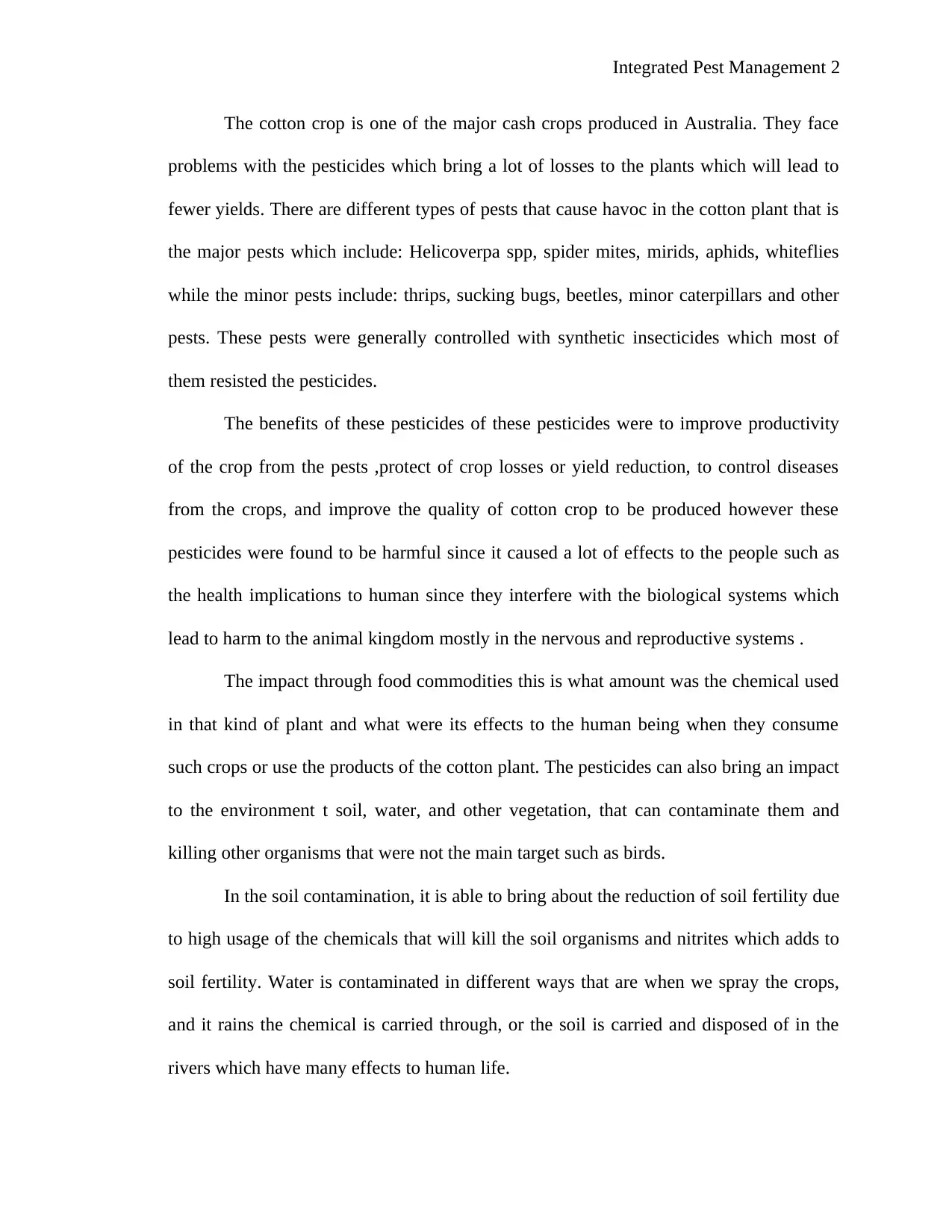
Integrated Pest Management 2
The cotton crop is one of the major cash crops produced in Australia. They face
problems with the pesticides which bring a lot of losses to the plants which will lead to
fewer yields. There are different types of pests that cause havoc in the cotton plant that is
the major pests which include: Helicoverpa spp, spider mites, mirids, aphids, whiteflies
while the minor pests include: thrips, sucking bugs, beetles, minor caterpillars and other
pests. These pests were generally controlled with synthetic insecticides which most of
them resisted the pesticides.
The benefits of these pesticides of these pesticides were to improve productivity
of the crop from the pests ,protect of crop losses or yield reduction, to control diseases
from the crops, and improve the quality of cotton crop to be produced however these
pesticides were found to be harmful since it caused a lot of effects to the people such as
the health implications to human since they interfere with the biological systems which
lead to harm to the animal kingdom mostly in the nervous and reproductive systems .
The impact through food commodities this is what amount was the chemical used
in that kind of plant and what were its effects to the human being when they consume
such crops or use the products of the cotton plant. The pesticides can also bring an impact
to the environment t soil, water, and other vegetation, that can contaminate them and
killing other organisms that were not the main target such as birds.
In the soil contamination, it is able to bring about the reduction of soil fertility due
to high usage of the chemicals that will kill the soil organisms and nitrites which adds to
soil fertility. Water is contaminated in different ways that are when we spray the crops,
and it rains the chemical is carried through, or the soil is carried and disposed of in the
rivers which have many effects to human life.
The cotton crop is one of the major cash crops produced in Australia. They face
problems with the pesticides which bring a lot of losses to the plants which will lead to
fewer yields. There are different types of pests that cause havoc in the cotton plant that is
the major pests which include: Helicoverpa spp, spider mites, mirids, aphids, whiteflies
while the minor pests include: thrips, sucking bugs, beetles, minor caterpillars and other
pests. These pests were generally controlled with synthetic insecticides which most of
them resisted the pesticides.
The benefits of these pesticides of these pesticides were to improve productivity
of the crop from the pests ,protect of crop losses or yield reduction, to control diseases
from the crops, and improve the quality of cotton crop to be produced however these
pesticides were found to be harmful since it caused a lot of effects to the people such as
the health implications to human since they interfere with the biological systems which
lead to harm to the animal kingdom mostly in the nervous and reproductive systems .
The impact through food commodities this is what amount was the chemical used
in that kind of plant and what were its effects to the human being when they consume
such crops or use the products of the cotton plant. The pesticides can also bring an impact
to the environment t soil, water, and other vegetation, that can contaminate them and
killing other organisms that were not the main target such as birds.
In the soil contamination, it is able to bring about the reduction of soil fertility due
to high usage of the chemicals that will kill the soil organisms and nitrites which adds to
soil fertility. Water is contaminated in different ways that are when we spray the crops,
and it rains the chemical is carried through, or the soil is carried and disposed of in the
rivers which have many effects to human life.
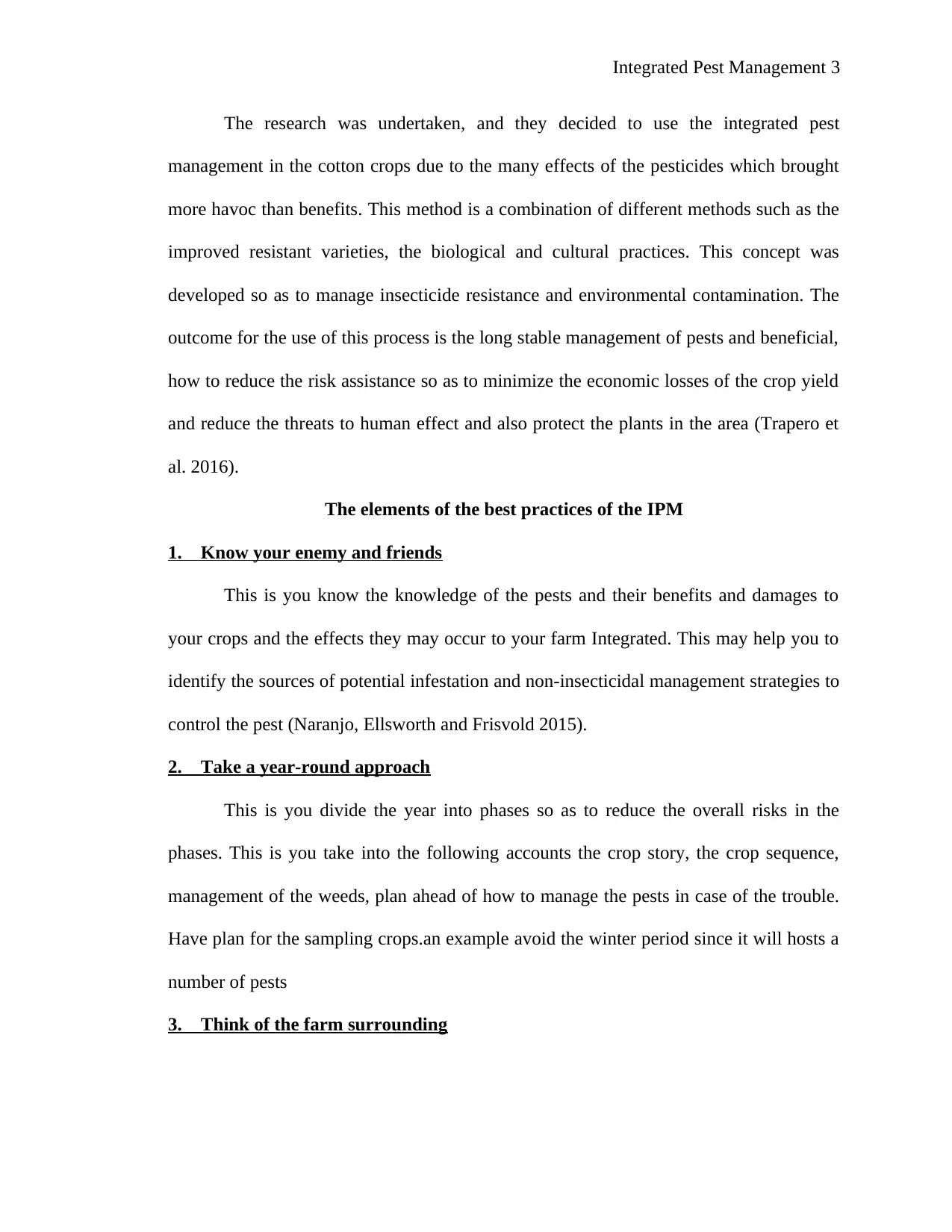
Integrated Pest Management 3
The research was undertaken, and they decided to use the integrated pest
management in the cotton crops due to the many effects of the pesticides which brought
more havoc than benefits. This method is a combination of different methods such as the
improved resistant varieties, the biological and cultural practices. This concept was
developed so as to manage insecticide resistance and environmental contamination. The
outcome for the use of this process is the long stable management of pests and beneficial,
how to reduce the risk assistance so as to minimize the economic losses of the crop yield
and reduce the threats to human effect and also protect the plants in the area (Trapero et
al. 2016).
The elements of the best practices of the IPM
1. Know your enemy and friends
This is you know the knowledge of the pests and their benefits and damages to
your crops and the effects they may occur to your farm Integrated. This may help you to
identify the sources of potential infestation and non-insecticidal management strategies to
control the pest (Naranjo, Ellsworth and Frisvold 2015).
2. Take a year-round approach
This is you divide the year into phases so as to reduce the overall risks in the
phases. This is you take into the following accounts the crop story, the crop sequence,
management of the weeds, plan ahead of how to manage the pests in case of the trouble.
Have plan for the sampling crops.an example avoid the winter period since it will hosts a
number of pests
3. Think of the farm surrounding
The research was undertaken, and they decided to use the integrated pest
management in the cotton crops due to the many effects of the pesticides which brought
more havoc than benefits. This method is a combination of different methods such as the
improved resistant varieties, the biological and cultural practices. This concept was
developed so as to manage insecticide resistance and environmental contamination. The
outcome for the use of this process is the long stable management of pests and beneficial,
how to reduce the risk assistance so as to minimize the economic losses of the crop yield
and reduce the threats to human effect and also protect the plants in the area (Trapero et
al. 2016).
The elements of the best practices of the IPM
1. Know your enemy and friends
This is you know the knowledge of the pests and their benefits and damages to
your crops and the effects they may occur to your farm Integrated. This may help you to
identify the sources of potential infestation and non-insecticidal management strategies to
control the pest (Naranjo, Ellsworth and Frisvold 2015).
2. Take a year-round approach
This is you divide the year into phases so as to reduce the overall risks in the
phases. This is you take into the following accounts the crop story, the crop sequence,
management of the weeds, plan ahead of how to manage the pests in case of the trouble.
Have plan for the sampling crops.an example avoid the winter period since it will hosts a
number of pests
3. Think of the farm surrounding
⊘ This is a preview!⊘
Do you want full access?
Subscribe today to unlock all pages.

Trusted by 1+ million students worldwide
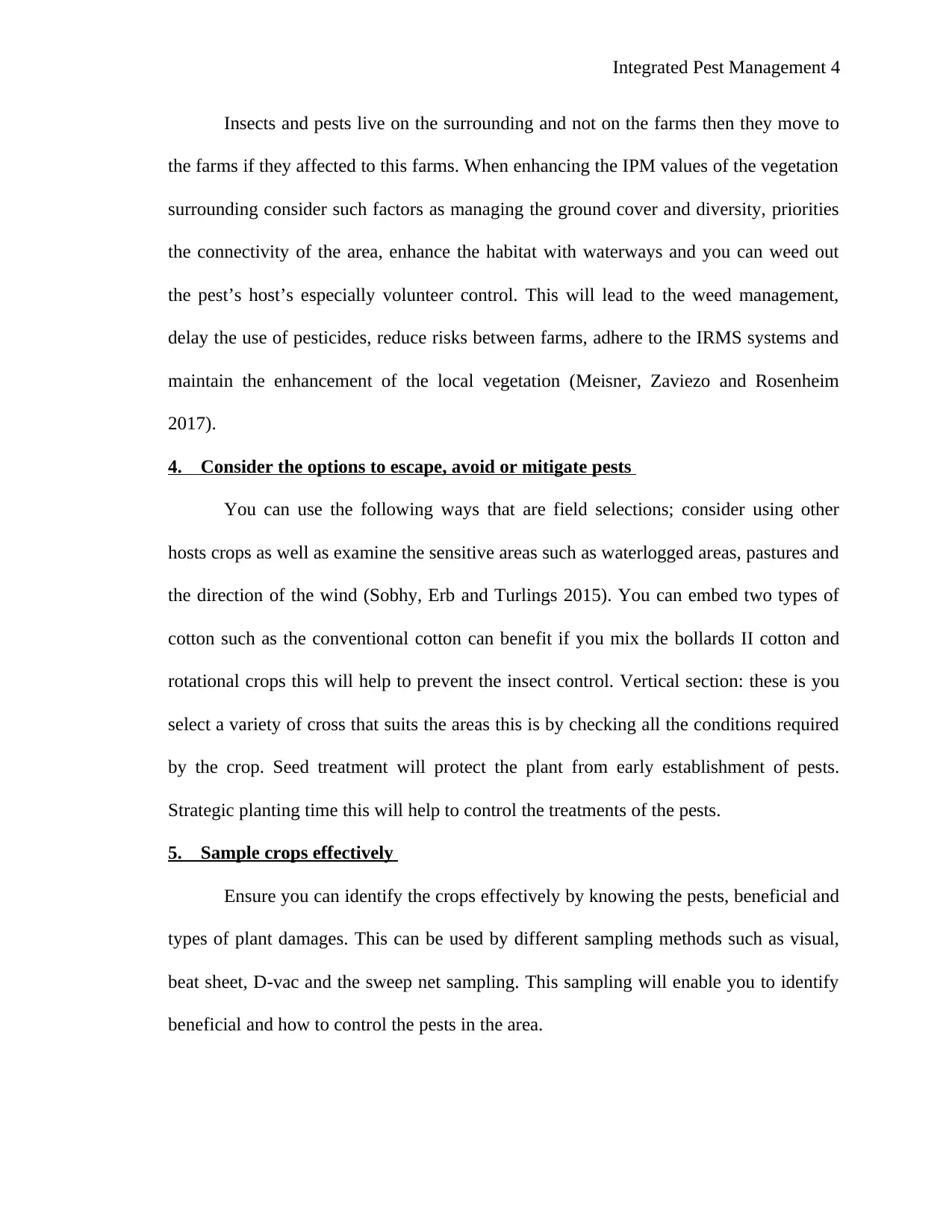
Integrated Pest Management 4
Insects and pests live on the surrounding and not on the farms then they move to
the farms if they affected to this farms. When enhancing the IPM values of the vegetation
surrounding consider such factors as managing the ground cover and diversity, priorities
the connectivity of the area, enhance the habitat with waterways and you can weed out
the pest’s host’s especially volunteer control. This will lead to the weed management,
delay the use of pesticides, reduce risks between farms, adhere to the IRMS systems and
maintain the enhancement of the local vegetation (Meisner, Zaviezo and Rosenheim
2017).
4. Consider the options to escape, avoid or mitigate pests
You can use the following ways that are field selections; consider using other
hosts crops as well as examine the sensitive areas such as waterlogged areas, pastures and
the direction of the wind (Sobhy, Erb and Turlings 2015). You can embed two types of
cotton such as the conventional cotton can benefit if you mix the bollards II cotton and
rotational crops this will help to prevent the insect control. Vertical section: these is you
select a variety of cross that suits the areas this is by checking all the conditions required
by the crop. Seed treatment will protect the plant from early establishment of pests.
Strategic planting time this will help to control the treatments of the pests.
5. Sample crops effectively
Ensure you can identify the crops effectively by knowing the pests, beneficial and
types of plant damages. This can be used by different sampling methods such as visual,
beat sheet, D-vac and the sweep net sampling. This sampling will enable you to identify
beneficial and how to control the pests in the area.
Insects and pests live on the surrounding and not on the farms then they move to
the farms if they affected to this farms. When enhancing the IPM values of the vegetation
surrounding consider such factors as managing the ground cover and diversity, priorities
the connectivity of the area, enhance the habitat with waterways and you can weed out
the pest’s host’s especially volunteer control. This will lead to the weed management,
delay the use of pesticides, reduce risks between farms, adhere to the IRMS systems and
maintain the enhancement of the local vegetation (Meisner, Zaviezo and Rosenheim
2017).
4. Consider the options to escape, avoid or mitigate pests
You can use the following ways that are field selections; consider using other
hosts crops as well as examine the sensitive areas such as waterlogged areas, pastures and
the direction of the wind (Sobhy, Erb and Turlings 2015). You can embed two types of
cotton such as the conventional cotton can benefit if you mix the bollards II cotton and
rotational crops this will help to prevent the insect control. Vertical section: these is you
select a variety of cross that suits the areas this is by checking all the conditions required
by the crop. Seed treatment will protect the plant from early establishment of pests.
Strategic planting time this will help to control the treatments of the pests.
5. Sample crops effectively
Ensure you can identify the crops effectively by knowing the pests, beneficial and
types of plant damages. This can be used by different sampling methods such as visual,
beat sheet, D-vac and the sweep net sampling. This sampling will enable you to identify
beneficial and how to control the pests in the area.
Paraphrase This Document
Need a fresh take? Get an instant paraphrase of this document with our AI Paraphraser
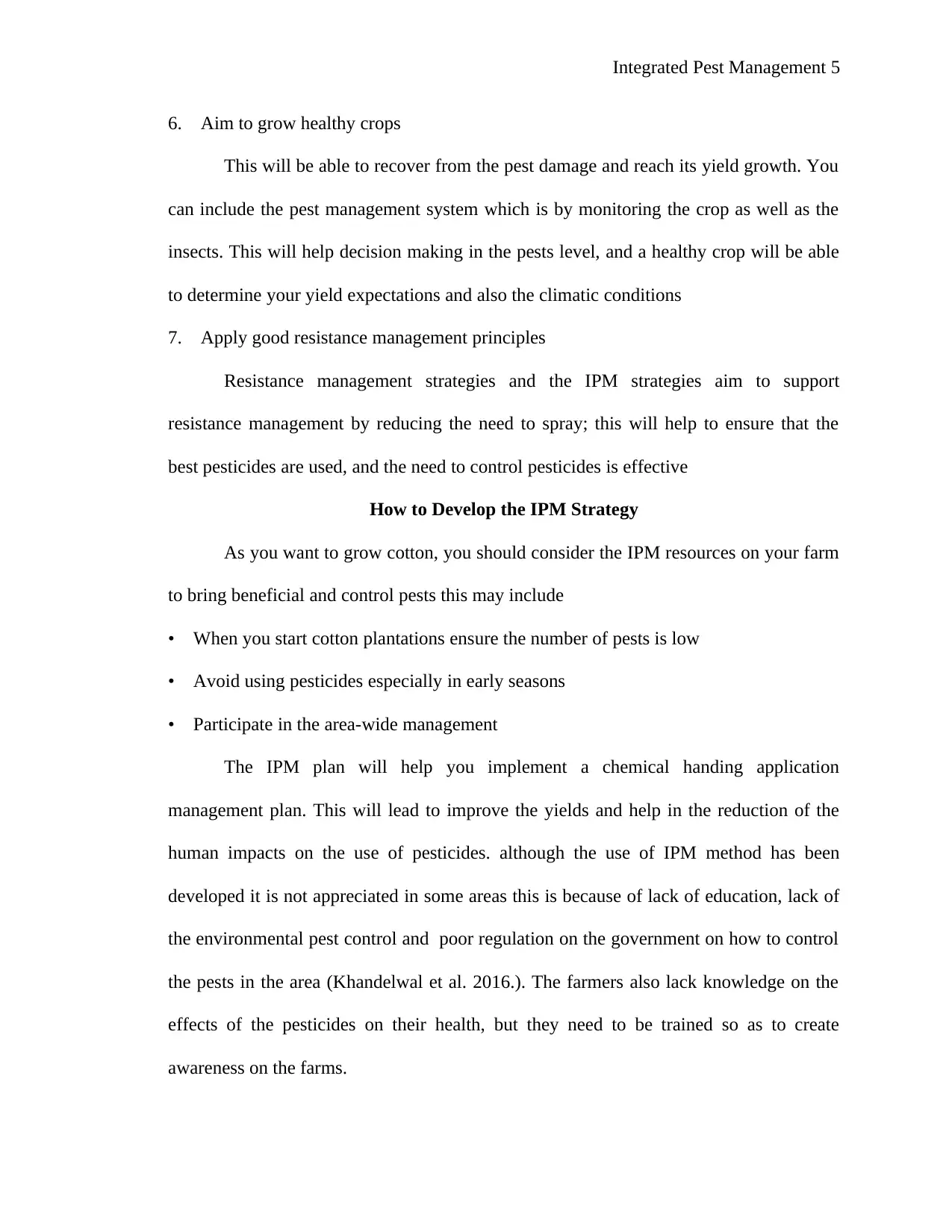
Integrated Pest Management 5
6. Aim to grow healthy crops
This will be able to recover from the pest damage and reach its yield growth. You
can include the pest management system which is by monitoring the crop as well as the
insects. This will help decision making in the pests level, and a healthy crop will be able
to determine your yield expectations and also the climatic conditions
7. Apply good resistance management principles
Resistance management strategies and the IPM strategies aim to support
resistance management by reducing the need to spray; this will help to ensure that the
best pesticides are used, and the need to control pesticides is effective
How to Develop the IPM Strategy
As you want to grow cotton, you should consider the IPM resources on your farm
to bring beneficial and control pests this may include
• When you start cotton plantations ensure the number of pests is low
• Avoid using pesticides especially in early seasons
• Participate in the area-wide management
The IPM plan will help you implement a chemical handing application
management plan. This will lead to improve the yields and help in the reduction of the
human impacts on the use of pesticides. although the use of IPM method has been
developed it is not appreciated in some areas this is because of lack of education, lack of
the environmental pest control and poor regulation on the government on how to control
the pests in the area (Khandelwal et al. 2016.). The farmers also lack knowledge on the
effects of the pesticides on their health, but they need to be trained so as to create
awareness on the farms.
6. Aim to grow healthy crops
This will be able to recover from the pest damage and reach its yield growth. You
can include the pest management system which is by monitoring the crop as well as the
insects. This will help decision making in the pests level, and a healthy crop will be able
to determine your yield expectations and also the climatic conditions
7. Apply good resistance management principles
Resistance management strategies and the IPM strategies aim to support
resistance management by reducing the need to spray; this will help to ensure that the
best pesticides are used, and the need to control pesticides is effective
How to Develop the IPM Strategy
As you want to grow cotton, you should consider the IPM resources on your farm
to bring beneficial and control pests this may include
• When you start cotton plantations ensure the number of pests is low
• Avoid using pesticides especially in early seasons
• Participate in the area-wide management
The IPM plan will help you implement a chemical handing application
management plan. This will lead to improve the yields and help in the reduction of the
human impacts on the use of pesticides. although the use of IPM method has been
developed it is not appreciated in some areas this is because of lack of education, lack of
the environmental pest control and poor regulation on the government on how to control
the pests in the area (Khandelwal et al. 2016.). The farmers also lack knowledge on the
effects of the pesticides on their health, but they need to be trained so as to create
awareness on the farms.
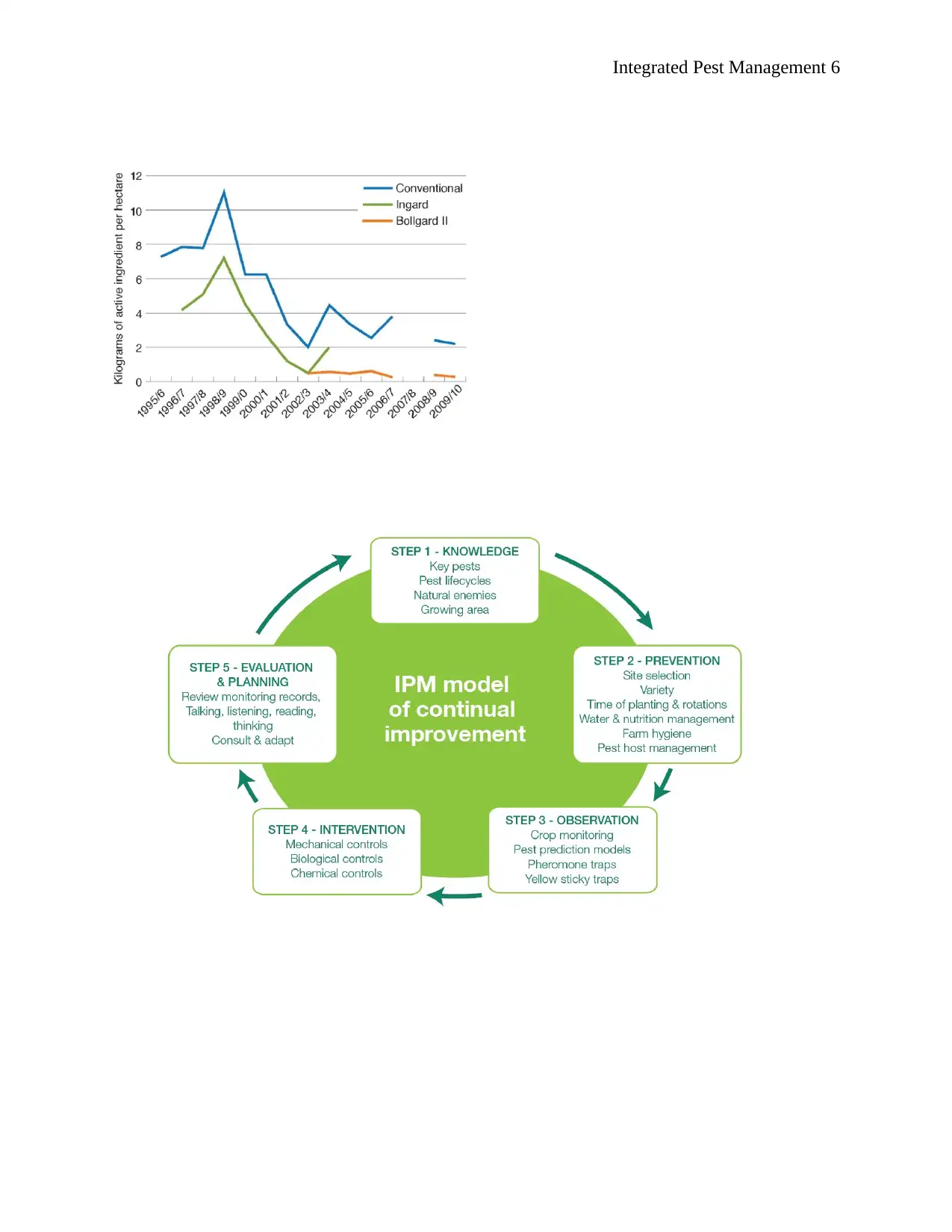
Integrated Pest Management 6
⊘ This is a preview!⊘
Do you want full access?
Subscribe today to unlock all pages.

Trusted by 1+ million students worldwide
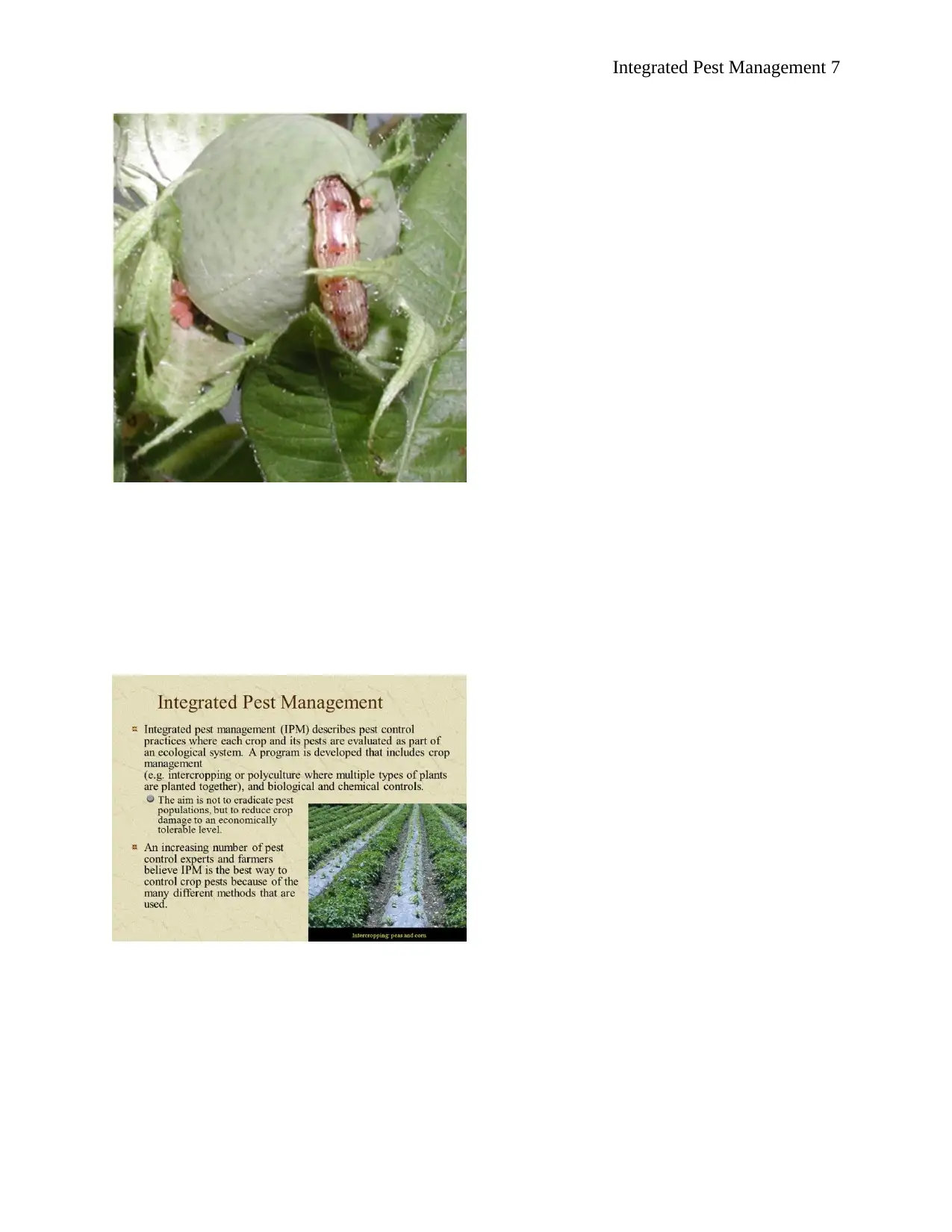
Integrated Pest Management 7
Paraphrase This Document
Need a fresh take? Get an instant paraphrase of this document with our AI Paraphraser
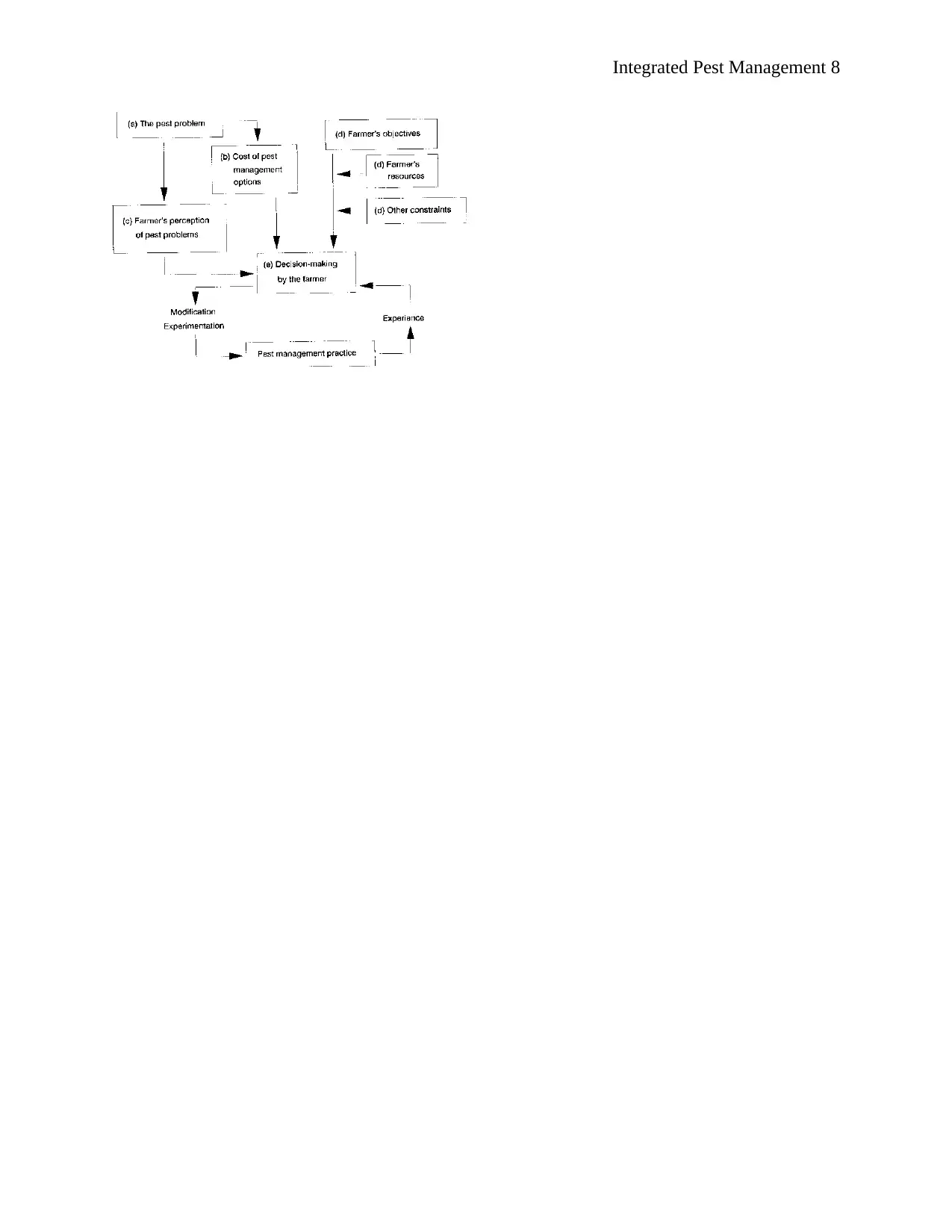
Integrated Pest Management 8
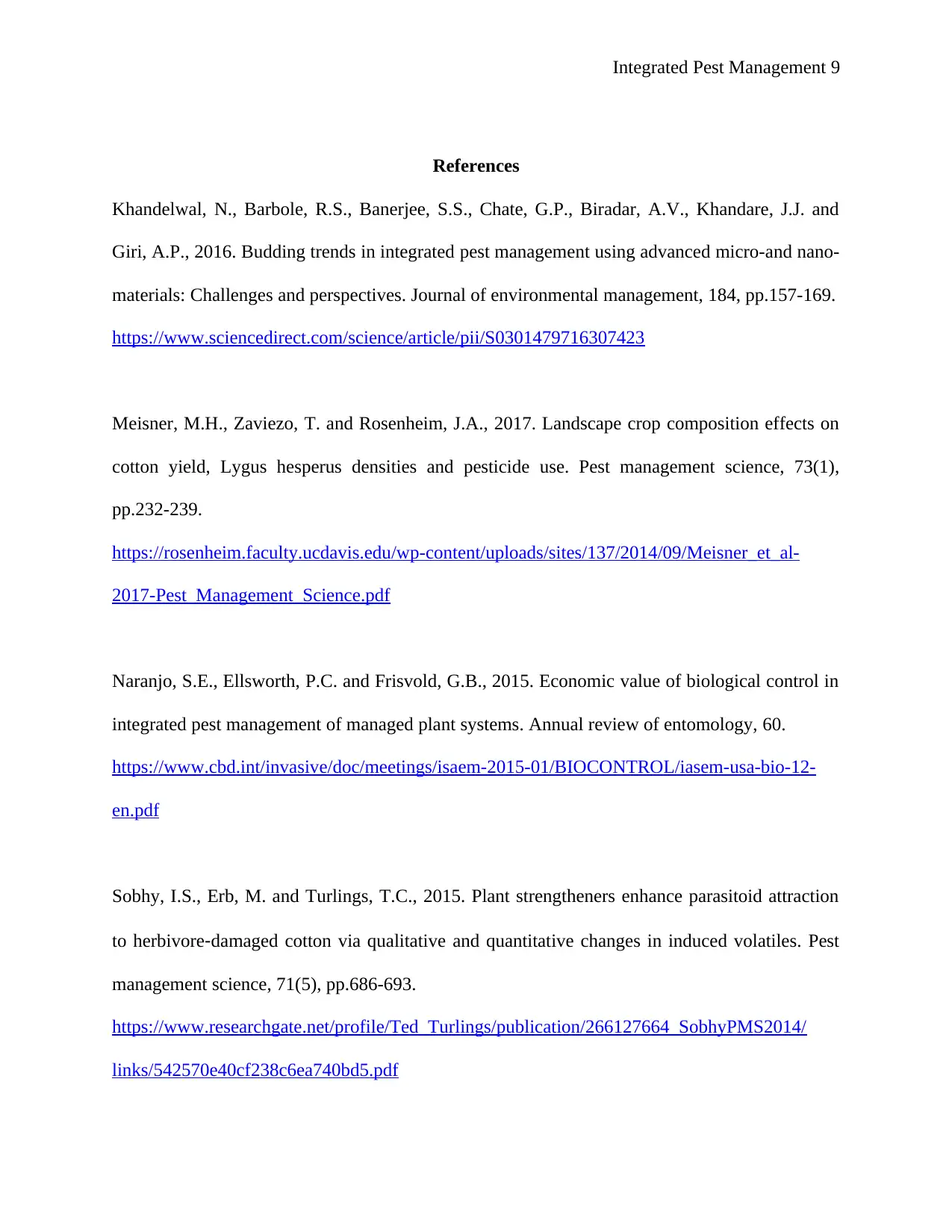
Integrated Pest Management 9
References
Khandelwal, N., Barbole, R.S., Banerjee, S.S., Chate, G.P., Biradar, A.V., Khandare, J.J. and
Giri, A.P., 2016. Budding trends in integrated pest management using advanced micro-and nano-
materials: Challenges and perspectives. Journal of environmental management, 184, pp.157-169.
https://www.sciencedirect.com/science/article/pii/S0301479716307423
Meisner, M.H., Zaviezo, T. and Rosenheim, J.A., 2017. Landscape crop composition effects on
cotton yield, Lygus hesperus densities and pesticide use. Pest management science, 73(1),
pp.232-239.
https://rosenheim.faculty.ucdavis.edu/wp-content/uploads/sites/137/2014/09/Meisner_et_al-
2017-Pest_Management_Science.pdf
Naranjo, S.E., Ellsworth, P.C. and Frisvold, G.B., 2015. Economic value of biological control in
integrated pest management of managed plant systems. Annual review of entomology, 60.
https://www.cbd.int/invasive/doc/meetings/isaem-2015-01/BIOCONTROL/iasem-usa-bio-12-
en.pdf
Sobhy, I.S., Erb, M. and Turlings, T.C., 2015. Plant strengtheners enhance parasitoid attraction
to herbivore‐damaged cotton via qualitative and quantitative changes in induced volatiles. Pest
management science, 71(5), pp.686-693.
https://www.researchgate.net/profile/Ted_Turlings/publication/266127664_SobhyPMS2014/
links/542570e40cf238c6ea740bd5.pdf
References
Khandelwal, N., Barbole, R.S., Banerjee, S.S., Chate, G.P., Biradar, A.V., Khandare, J.J. and
Giri, A.P., 2016. Budding trends in integrated pest management using advanced micro-and nano-
materials: Challenges and perspectives. Journal of environmental management, 184, pp.157-169.
https://www.sciencedirect.com/science/article/pii/S0301479716307423
Meisner, M.H., Zaviezo, T. and Rosenheim, J.A., 2017. Landscape crop composition effects on
cotton yield, Lygus hesperus densities and pesticide use. Pest management science, 73(1),
pp.232-239.
https://rosenheim.faculty.ucdavis.edu/wp-content/uploads/sites/137/2014/09/Meisner_et_al-
2017-Pest_Management_Science.pdf
Naranjo, S.E., Ellsworth, P.C. and Frisvold, G.B., 2015. Economic value of biological control in
integrated pest management of managed plant systems. Annual review of entomology, 60.
https://www.cbd.int/invasive/doc/meetings/isaem-2015-01/BIOCONTROL/iasem-usa-bio-12-
en.pdf
Sobhy, I.S., Erb, M. and Turlings, T.C., 2015. Plant strengtheners enhance parasitoid attraction
to herbivore‐damaged cotton via qualitative and quantitative changes in induced volatiles. Pest
management science, 71(5), pp.686-693.
https://www.researchgate.net/profile/Ted_Turlings/publication/266127664_SobhyPMS2014/
links/542570e40cf238c6ea740bd5.pdf
⊘ This is a preview!⊘
Do you want full access?
Subscribe today to unlock all pages.

Trusted by 1+ million students worldwide
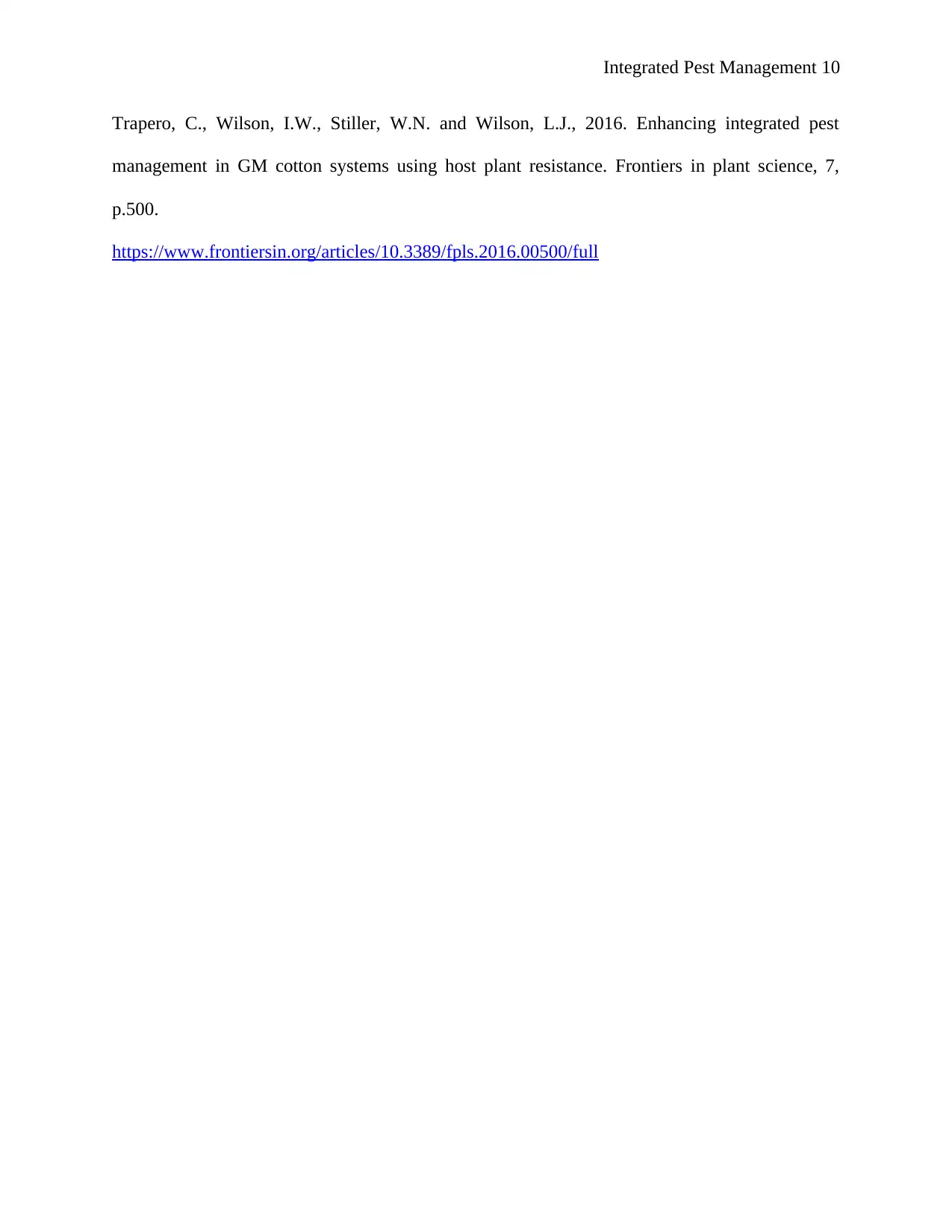
Integrated Pest Management 10
Trapero, C., Wilson, I.W., Stiller, W.N. and Wilson, L.J., 2016. Enhancing integrated pest
management in GM cotton systems using host plant resistance. Frontiers in plant science, 7,
p.500.
https://www.frontiersin.org/articles/10.3389/fpls.2016.00500/full
Trapero, C., Wilson, I.W., Stiller, W.N. and Wilson, L.J., 2016. Enhancing integrated pest
management in GM cotton systems using host plant resistance. Frontiers in plant science, 7,
p.500.
https://www.frontiersin.org/articles/10.3389/fpls.2016.00500/full
1 out of 10
Related Documents
Your All-in-One AI-Powered Toolkit for Academic Success.
+13062052269
info@desklib.com
Available 24*7 on WhatsApp / Email
![[object Object]](/_next/static/media/star-bottom.7253800d.svg)
Unlock your academic potential
Copyright © 2020–2025 A2Z Services. All Rights Reserved. Developed and managed by ZUCOL.





